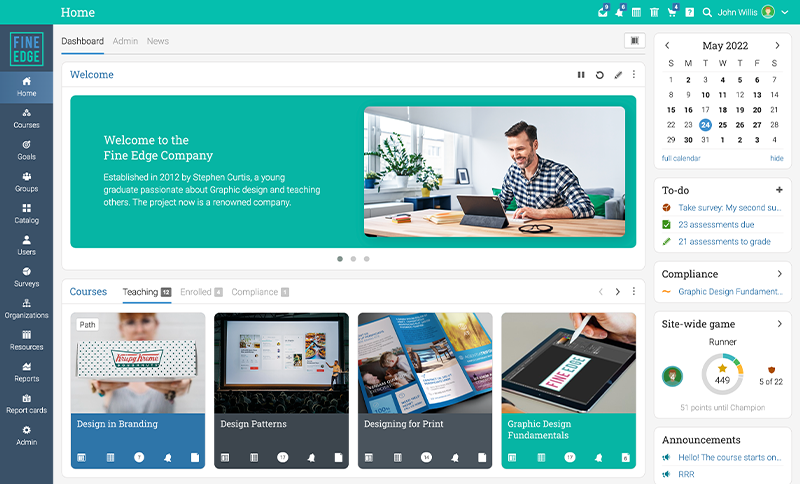Mentorship programs have become quite the norm in the corporate environment and as a result, we tend to think of them as very recent, but they have been around for quite a while. In fact, 84% of US Fortune 500 companies have mentorship programs and all US Fortune 50 companies use them. It’s no wonder that US Fortune 500 companies did better during the Covid-19 economic downturn in terms of profits than companies that didn’t offer these opportunities. Consequently, businesses that invest in their people avoid losing talent and have lower turnover rates.
The economic effects of the pandemic are still in full swing. One of them is the now famous The Great Resignation. An increasing number of employees leaving their jobs comes at a high price for organizations as the average cost of a single resignation is 11,372 dollars per employee. But apart from money, companies lose a lot of talent and that is even more damaging in the long run.
Among the reasons why so many people are looking for new jobs, higher pay ranks highest followed by a lack of opportunities for development and advancement. The purpose of mentorship programs is to offer employees the opportunity to grow and learn while feeling like valuable members of the organization. They are beneficial not only to mentees who get the support they need but also to mentors who are acknowledged as talented individuals who can offer guidance. As a result, they are less likely to look for career opportunities elsewhere.
In this article, we’ll explore remote mentorship and how an modern learning platform can help any organization make this program a success.
What makes a mentorship program successful?
Mentors come in many forms. In this article, I will focus on formal mentoring programs as Informal mentoring is often a matter of chance and its effectiveness is harder to measure. With a part of the workforce still working remotely and planning on remaining this way, organizations need to find ways to replace face-to-face peer interaction. A well-organized and transparent mentorship program can do just that. While every company is different and corporate cultures vary, a few characteristics apply to all successful mentoring programs:
Thoughtful design
Even if you feel a sense of urgency about creating a mentorship program for your organization, you need to take the time to make sure you do it properly. Think about the objectives, how you will measure them, and who will be responsible for each part of the program. For instance, figure out who the mentors will be and how they will connect with the mentees before launching the program.
A good mentorship training program
Some employees will have a natural tendency toward becoming mentors; others will not. On the other hand, mentees will join the program with different expectations, and their managers will also want various outcomes. You need to get everyone on the same page by offering formal instruction on what mentorship means and how it works in your organization. Employees will need just enough information to ensure that they have all they need to start.
Ownership and accountability
If you want your mentorship program to succeed, you need to be very clear about who is in charge. If you skip this step, it’s a good chance it will become an item in people’s calendars that they’ll keep postponing. Establish who the project sponsors are (C-suite, managers, L&D, etc.) and ensure you get them on board for their entire duration, as initial enthusiasm often fails when faced with obstacles.
Clear and measurable objectives
Mentorship programs require both money and time investments. You need to be able to prove a positive ROI. Existing statistics on how valuable mentorship is help when you need to get everyone on board with the idea. Once the program is underway, show how it works for your organization specifically. Survey all the stakeholders (mentors, mentees, and managers) regularly to get their input. Keep a database of all mentorship instances and look at employee trajectories to quantify progress.
Adaptability
Market conditions change, individual needs and aspirations change, and organizations are very dynamic – mergers and acquisitions set a new record in 2021. A good mentorship program aims to support employees in dealing with constant transformation. A mentor-mentee relationship is not static, which is one reason why mentorship is such an effective talent development method.
Read more: How many types of mentoring are there?
How to set up a remote mentorship program
Remote work comes with many benefits but has a few downsides as well. One of these is a lack of face-to-face communication with peers. Remote mentorship can mitigate the lack of in-person connections. Here are the steps to take when setting up a remote mentorship program:
-
Define the objectives
Companies can achieve many things through mentorship, including increased productivity, talent retention, lower turnover rates, and a boost in employee engagement. Find the items that are most important for the organization. Establish what success will look like in numbers because a good objective is attainable and measurable. This is very important for a remote mentorship program since things can fall “through the cracks” if nobody keeps score.
-
Establish ownership
It’s important to have a clear sense of who is responsible for what. This is especially relevant in a remote setting where people need the extra nudge to connect and communicate. Define the roles in great detail and get constant feedback. Having everyone on board is essential for the smooth unfolding of the program.
-
Choose an appropriate platform
For remote mentorship to work, you need a good virtual solution. Since mentorship is part of a greater L&D effort that includes training, coaching, etc., it makes sense to use the company’s learning platform for mentorship. Plus, a modern learning platform also has the appropriate communication tools, such as web conferencing, chat, messages, etc., so they don’t need to use other tools for remote mentorship meetings. It’s also easier for the organization to keep track of the program this way.
-
Find the mentors and mentees
Starting from the objectives you’ve established, see which of the company’s employees need the most support. Establish a mentee profile to determine what knowledge and skills you will look for in potential mentors. For example, leadership programs are most often combined with mentorship opportunities, so the mentors also need to have excellent leadership abilities, no matter their position. A modern learning platform helps you establish learning goals for each employee, so finding people with the right abilities is easier than ever.
 Each employee can set learning goals for themselves. Managers can also assign them to each team member.
Each employee can set learning goals for themselves. Managers can also assign them to each team member. -
Set up mentorship accounts
While you are looking for experienced employees who can help others with their development, keep in mind that there is a lot in it for mentors as well. For example, through CYPHER's modern learning platform, you can add mentor accounts so people will also have this title as well as their job role.
 LMS mentorship accounts make it easy for mentees to find mentors as well as offer some privileges to the mentors themselves.
LMS mentorship accounts make it easy for mentees to find mentors as well as offer some privileges to the mentors themselves. -
Pair mentees and mentors
Pairing mentees and mentors can be done by an L&D specialist. However, it’s also effective to use a specially designed tool. The CYPHER modern learning platform can also assist with this. For example, employees can set up learning goals directly on the platform. One of the goals can be “I want to become a team leader.” Then, the platform automatically recommends not only training resources, but also the option to “contact a mentor” who has completed the goal and has the appropriate skills. Consequently, communication through the platform can begin immediately.
Read more: Using mentoring as a leadership accelerator within your organization
-
Have a mentorship workflow
Your mentorship program doesn’t have to be more complicated than a training program. On the contrary, it should be easier to work with. For instance, using CYPHER, you can set up groups for mentors where they can discuss and exchange ideas. In the same vein, you can establish whether the program will be:
- Face-to-face and partially online: this means that the mentorship meetings are in person, but mentors can recommend learning resources online;
- Face-to-face and online: meetings take place both online and offline, depending on the mentees’ and mentors’ schedules;
- Completely remote: meetings are completely remote, through web conferencing, messages, email exchanges, learning content recommendations, etc.
Of course, you can find many other configurations to accommodate remote employees.
-
Provide mentorship training
Appropriate instruction is essential for the program to function flawlessly. Create an online course to cover all relevant information, from objectives and evaluations to logistics. If you are using a new tool, such as a new web conferencing solution, make sure there’s a tutorial for it.
Read more: The 3 keys to successful remote training
-
Add mentorship resources
As mentioned above, mentors have special accounts that allow them to recommend online courses, learning paths and many other learning resources to their mentees. It’s important that they have an extensive, integrated content library with both in-house and third-party resources.
-
Promote the mentorship program
A mentorship program may seem elitist at first glance. You don’t want employees to feel discouraged. Have a big launch and keep everyone in the loop about how things are going. Be transparent about eligibility and program expansion opportunities. For instance, you can promote the program by displaying a “welcome” banner that any employee can see when they log in to the platform and use it to promote the new program.
 Dashboard welcome banners can help you promote the mentorship program to all employees.
Dashboard welcome banners can help you promote the mentorship program to all employees. -
Assess and adapt
After the program has been running for some time (six months, for example), gather feedback and look at the existing results. For instance, use employee surveys to see how happy are they generally with the program and what needs to improve.
Creating the best remote mentorship programs
Mentorship programs have gone from “good to have” to “must-have.” In the context of seemingly permanent remote work, setting up an effective mentorship system can level the field for remote or hybrid employees and give their careers a well-deserved boost.
The keys to developing and deploying a good remote mentorship program are thoughtful design, accountability, clear, measurable objectives, and the appropriate logistics. The CYPHER platform helps organizations develop a skill map for each employee, set up mentor accounts and match mentees with mentors.







